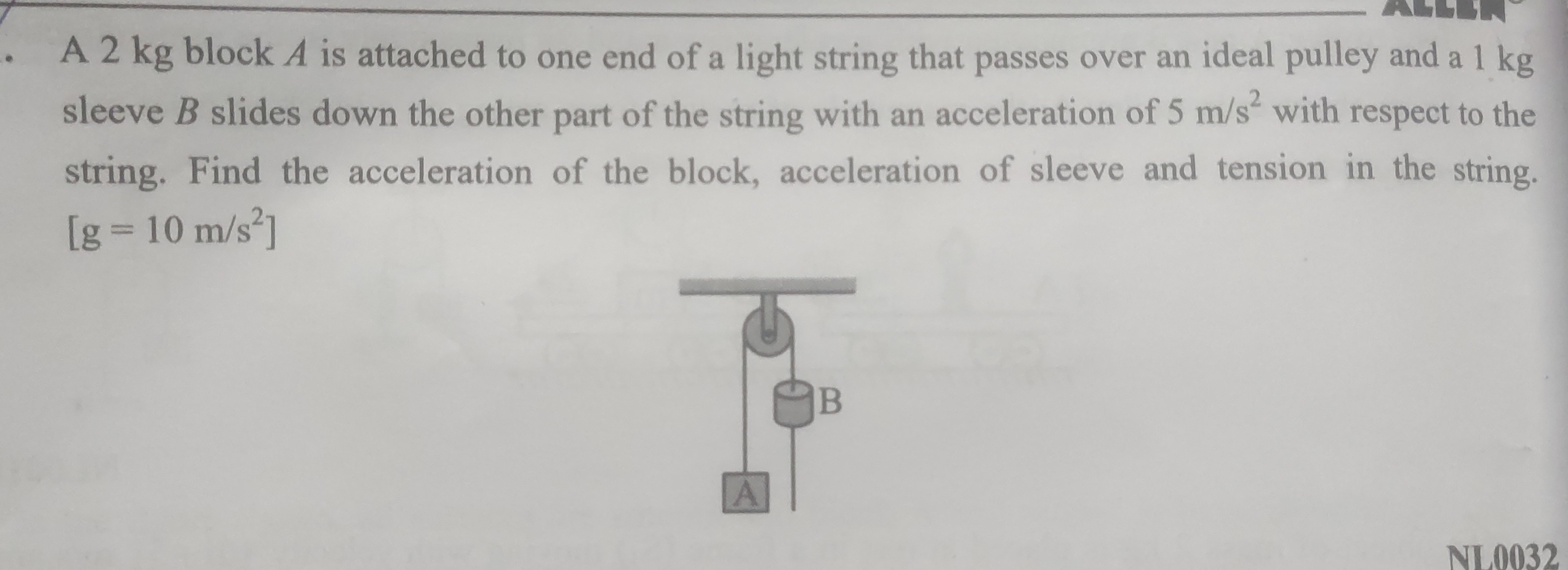Question
Question: A 2 kg block A is attached to one end of a light string that passes over an ideal pulley and a 1 kg ...
A 2 kg block A is attached to one end of a light string that passes over an ideal pulley and a 1 kg sleeve B slides down the other part of the string with an acceleration of 5 m/s² with respect to the string. Find the acceleration of the block, acceleration of sleeve and tension in the string. [g = 10 m/s²]

Acceleration of block = 5 m/s² downwards, Acceleration of sleeve = 0 m/s², Tension in string = 10 N
Solution
The problem involves a block, a sleeve, an ideal pulley, and a string. We need to apply Newton's second law and the concept of relative acceleration.
Given:
- Mass of block A, mA=2 kg
- Mass of sleeve B, mB=1 kg
- Acceleration of sleeve B with respect to the string, aB,S=5m/s2 (downwards along the string)
- Acceleration due to gravity, g=10m/s2
1. Define Accelerations and Directions:
Let aA be the magnitude of the acceleration of block A.
Let aB be the magnitude of the absolute acceleration of sleeve B (relative to the ground).
Let's assume block A moves downwards. Therefore, the string on A's side moves downwards with acceleration aA. Consequently, the string on B's side moves upwards with acceleration aA.
2. Relative Acceleration Relationship:
The absolute acceleration of sleeve B (aB) is the vector sum of its acceleration relative to the string (aB,S) and the acceleration of the string relative to the ground (aS,G).
Since aB,S is downwards (5 m/s²) and the string on B's side is moving upwards with aA, we can write:
aB=aB,S−aA (taking downwards as positive for sleeve B)
aB=5−aA (Equation 1)
3. Free Body Diagrams and Equations of Motion:
-
For Block A:
Forces acting on block A:- Weight mAg acting downwards.
- Tension T acting upwards.
Assuming A moves downwards, apply Newton's second law (Fnet=ma):
mAg−T=mAaA
2(10)−T=2aA
20−T=2aA (Equation 2)
-
For Sleeve B:
Forces acting on sleeve B:- Weight mBg acting downwards.
- Tension T acting upwards (from the string passing through it).
Assuming B moves downwards (which is consistent with aB,S being downwards), apply Newton's second law:
mBg−T=mBaB
1(10)−T=1aB
10−T=aB (Equation 3)
4. Solve the System of Equations:
Substitute Equation 1 into Equation 3:
10−T=(5−aA)
From this, we can express T:
T=10−(5−aA)
T=5+aA (Equation 4)
Now substitute Equation 4 into Equation 2:
20−(5+aA)=2aA
15−aA=2aA
15=3aA
aA=315
aA=5m/s2
Since aA is positive, our initial assumption that block A moves downwards is correct.
5. Calculate Tension and Acceleration of Sleeve B:
-
Acceleration of the block (A):
aA=5m/s2 (downwards) -
Tension in the string (T):
Substitute aA=5m/s2 into Equation 4:
T=5+5
T=10N -
Acceleration of the sleeve (B):
Substitute aA=5m/s2 into Equation 1:
aB=5−aA
aB=5−5
aB=0m/s2
This means sleeve B remains stationary relative to the ground while sliding down the string.
